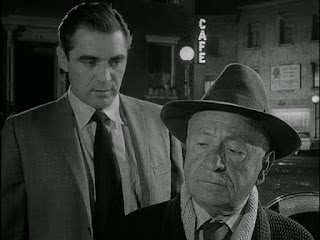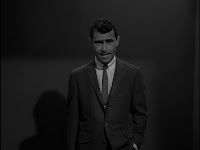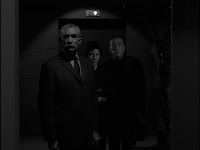 |
| Warren Stevens as Nate Bledsoe |
"Dead Man's Shoes"
Season Three, Episode 83
Original
Air Date: January 19, 1962
Cast:
Nate
Bledsoe: Warren Stevens
Dagget:
Richard Devon
Wilma:
Joan Marshall
Chips:
Ben Wright
Sam:
Harry Swoger
Ben:
Ron Hagerthy
Dagget's
Woman: Florence Marly
Jimmy:
Joe Mell
Maitre
d': Eugene Borden
Crew:
Writers:
Charles Beaumont and OCee Ritch
Director:
Montgomery Pittman
Producer:
Buck Houghton
Production
Manager: Ralph W. Nelson
Director
of Photography: George T. Clemens
Art
Direction: George W. Davis and Phil Barber
Set
Decoration: H. Web Arrowsmith
Assistant
Director: E. Darrell Hallenbeck
Casting:
Stalmaster-Lister
Editor:
Jason H. Bernie
Story
Consultant: Richard McDonagh
Sound:
Franklin Milton and Bill Edmondson
Music:
stock
And Now, Mr. Serling:
"Next
week, through the good offices of Mr. Charles Beaumont, we take a walk in some
'Dead Man's Shoes.' It's the story of a hobo who takes some shoes off a
recently deceased hoodlum and then discovers that if the shoe fits you have to
wear it. And, in this case, you have to do as the shoes do, go where they tell
you to, and then perform some services above and beyond the norm. I hope we see
you next week for 'Dead Man's Shoes.'"
Rod Serling's Opening Narration:
"Nathan
Edward Bledsoe of the Bowery Bledsoes. A man once, a specter now, one of those
myriad modern-day ghosts that haunt the reeking nights of the city in search of
a flop, a handout, a glass of forgetfulness. Nate doesn't know it but his
search is about to end. Because those shiny new shoes are going to carry him
right into the capital of The
Twilight Zone."
Summary:
In the early night hours, a dark sedan pulls into an alleyway and dumps
a dead body beneath a tenement staircase. The sound of the car awakens Nate
Bledsoe, a homeless man sleeping on a bed of newspapers. Nate spies the dead
body and proceeds to turn out the pockets of the corpse. Then he sees the nice
pair of shoes on the corpse and switches them for his own worn-out shoes.
Walking down the street, he is accosted by two fellow homeless men who inquire
as to where Nate came upon the nice shoes. But Nate seems confused and much
gruffer than his usual meek self. Nate shrugs off the two men and heads to an
apartment building on the nicer side of town.
There
he walks in on Wilma, a beautiful woman alone in a top floor apartment. She demands
to know who he is. When she sees the shoes on Nate’s feet she recognizes them
as belonging to her boyfriend Dane, now a shoeless corpse in an alley across
town. Dane may be dead but he’s still pretty lively when Nate’s wearing his
shoes.
Nate
comes back to himself when he takes off Dane’s shoes. He doesn’t know where he
is or how he got there. Wilma points a gun at him and demands that Nate leave
the apartment. When Nate puts the shoes back on, Dane resumes control and
easily takes the gun away from Wilma. He kisses her furiously like Dane used to
kiss her. Wilma goes into hysterics and Dane slaps her across the face. He’s
got business to attend to and Wilma better be there when he gets back.
Nate/Dane
makes his way to a nightclub where he sits close to a table of gangsters and
orders tequila with a lump of sugar. Dane’s signature drink. That gets their
attention. They don’t recognize Nate so they call him over to the table and ask
him who he is and what he’s up to. Nate/Dane tells them that he’s a messenger
and he has a private message for Dagget, the leader of the little group.
Alone
in Dagget’s office, Nate/Dane openly talks of Dane’s murder at the hands of
Dagget and his goons. Nate/Dane pulls out a hidden gun. One of Dagget’s men
springs from a hidden panel in the wall but Nate/Dane gets the drop on him.
“You didn’t think that would work twice, did you?” Dane asks. Another of
Dagget’s men shoots Nate/Dane though a space in bookcase that conceals another
hidden panel.
“I’ll
be back,” Dane warns as he lies dying on the floor of Dagget’s office for the
second time that night. “I’ll be back again and again until I get you.”
Dagget
and his men dump Nate’s body in an alley. One of Nate’s fellow homeless friends
takes the shoes from Nate’s body and puts them on.
Rod Serling's Closing Narration:
"There's
an old saying that goes: 'If the shoe fits, wear it.' But be careful. If you
happen to find a pair of size nine black and grey loafers, made to order in the
old country, be very careful. You might walk right into The Twilight Zone."
Commentary:
“Dead Man’s Shoes” is a breezily entertaining but undistinguished offering from the otherwise exceptional duo of writer Charles
Beaumont and director Montgomery Pittman. It is largely derivative in style and
subject, bearing a resemblance to the plot and structure of the
earlier episode “The Four of Us Are Dying,” along with a number
of other film noir offerings on the series. Like “The Four of Us Are
Dying,” it also features a jazzy, interpretive musical structure better suited to
a crime drama than a fantasy series.
Charles Beaumont had help scripting the episode from his friend and occasional collaborator OCee Ritch, who
does not receive credit on the episode and was previously a contributor to the series as the source (via unpublished story) for Beaumont’s second season offering
“Static.” In fact, “Dead Man’s Shoes” is a clear reversal of the process that
created “Static,” the latter of which concerned OCee Ritch’s idea adapted by
Beaumont whereas “Dead Man’s Shoes” concerns Beaumont’s idea adapted by Ritch. The episode was originally to concern a cowboy hat instead of
a pair of shoes. This approach leaned heavily toward comedy but Ritch managed
to combine the lighter material inherent in Beaumont’s original idea with an
urban edge populated by standard, underworld-type characters. This approach
was similar to the method by which Rod Serling adapted Henry Kuttner's and Catherine L. Moore's story “What You Need” for the first season.
Beaumont had yet to
display the symptoms of the terrible degenerative disease which would claim his
life just five years later but he remained a freelance writer unwilling to turn down an assignment. Beaumont was frequently
overworked and under pressure of deadlines. He’d long assumed the occasional
practice of farming out his ideas for his writer friends to flesh out in
television assignments to which he was contractually obligated. This practice
became more frequent as Beaumont began to succumb to the disease (generally
believed to be early-onset Alzheimer’s) that would ultimately take his life at the young age of 38.
OCee
Ritch and Charles Beaumont initially bonded over their shared loved of
automobiles and automotive racing. Ritch authored several manuals on motorcycle repair for the Chilton series of publications in the 1960's, and also contributed to a volume of
sports racing material compiled and edited by Beaumont and William F. Nolan (The Omnibus of Speed: An Introduction to the World of Motor Sport, G.P. Putnam's, 1958; "The Golden Days of Gilmore"). Beaumont and Ritch soon discovered a mutual love of nostalgia and collaborated (under Beaumont's name) on nostalgic essays for Playboy and other magazines ("The Bloody Pulps," "The Golden Age of Slapstick Comedy," "Don't Miss the Next Thrilling Chapter!"). Ritch's talent for dramatic writing was also apparent to Beaumont and, besides their two episodes on The Twilight Zone, the two writers produced collaborative efforts (under Beaumont's name) for The Alfred Hitchcock Hour ("The Long Silence," with William D. Gordon, based on "Composition for Four Hands" by Hilda Lawrence), Boris Karloff's Thriller ("Guillotine," based on a story by Cornell Woolrich), and Channing ("Gate to Nowhere"). Ritch also appeared in director Roger Corman’s 1962 adaptation of Charles
Beaumont’s 1959 novel The Intruder (along
with appearances by George Clayton Johnson and William F.
Nolan, and Beaumont himself). Ritch published an article on the making of the film in the December, 1961 issue of Rogue magazine.
Director
Montgomery Pittman graced the series for a brief time from the end of the
second season through the middle of the third season and brought with him both
a distinguished style and the distinguishing characteristic of being a director
that often wrote the episodes he directed. Pittman wrote three of the five
episodes he directed (the exceptions being Rod Serling’s “Will the Real Martian
Please Stand Up?” and “Dead Man’s Shoes”) and, like many of the series
directors, was adept at infusing an episode with a distinctive film noir
aesthetic.
Two
areas in which the series shines is in its variety and its outstanding stable of directors. Much like the varieties of writing on the series, Rod Serling and
producer Buck Houghton encouraged individual directors to work against any type
of “house” style to present unique visions on the series. This
practice was aided by the presence of cinematographer George T. Clemens, a man adroit at adapting to the individual
styles of the show’s many directors.
The Twilight Zone is often seen as a
science fiction series primarily concerned with the recognizable tropes of the
science fiction genre. Though the series did attempt several recognizable forms
of science fiction, from time travel to robots to dystopian futures to interplanetary
travel to alternate dimensions, the show took great efforts to attempt
virtually every form of popular storytelling. Beyond the experimental episodes
(including a couple of virtually silent episodes and one in which the faces of
the principle cast remain hidden) the series attempted everything from romance
to ghost stories to westerns to tales of war to screwball comedy. One style frequently staged on the series was that of film noir, a style distinguished by shadowy lighting and camera effects to illustrate tales of detectives and criminals.
It
should come as no surprise that the series would approach such subject matter
considering the unique type of urban fantasy the creators returned to time and
again, evident in such offerings as “What You Need,” “The Four of Us Are
Dying,” “Nervous Man in a Four Dollar Room,” “The Prime Mover,” “A Nice Place
to Visit,” and some half dozen more. It is even less surprising when one
surmises the talented directors Serling and company brought to the show,
several of whom made their reputations in film noir or in the
earlier, formative mode of expressionism, including Ida Lupino (also notable
for both acting and directing on the series as well as being the only female
director to helm an episode), Jacques Tourneur, Robert Florey, and John Brahm.
Montgomery
Pittman can be placed in that company as well if one looks to his small but varied
output and recognizes the noir-influence style he brings to tales as
diverse as “Two,” “The Grave,” and “The Last Rites of Jeff Myrtlebank.”
“Dead
Man’s Shoes,” however, is also part of a smaller subgenre occasionally seen on
the series which changes the tonal dynamic of the episode. It is a “magic item”
episode and, like its counterparts “A Penny for Your Thoughts,” “A Piano in the
House,” and “A Kind of Stopwatch,” there is a liberal sprinkling of levity into
the episode’s graver moments (the notable exception being the generally grim episode “What You Need”). One of the more amusing moments in
the episode is also the best scene, that in which Nate/Dane (Warren Stevens)
returns to Dane’s apartment and is confronted by Wilma (Joan Marshall), Dane’s
girlfriend. The moment in which Nate alternately removes the dead man’s shoes
and puts them on again is very amusing and played relatively straight. Pittman
chooses to focus on the facial expressions of the two principle actors
with effective medium shots. One method by which Ritch and Pittman tamper the
comedic impulse of the story is in the high level of abrupt violence which ends
the second and third acts. Most shocking is the level of domestic abuse which
Wilma sufferd under Dane as Nate/Dane both threaten to break her
arm and both strike her across the face in the space of a few minutes.
The pleasingly deadpan style of prolific actor Warren Stevens perfectly illuminates the
gallows humor characteristic of the material. Stevens saw Broadway early in his
acting career before moving into film and television, the latter medium
providing him with more than 150 credits, including plenty of genre material.
Stevens had a memorable role (and death) in the 1956 science fiction
film Forbidden Planet. On the small
screen Stevens appeared in episodes of Inner
Sanctum, Alfred Hitchcock Presents, Science Fiction Theatre, One Step Beyond,
Star Trek, and a long-running association with producer/director Irwin Allen, appearing in such Allen productions as Voyage to the Bottom of the Sea, The Time
Tunnel, Land of the Giants, and The
Return of Captain Nemo (also known as The Amazing Captain Nemo).
Joan
Marshall, who portrays Wilma and shares the best scene of the episode with
Stevens, has provided even more unique contributions to genre film and
television. Marshall used the stage name Jean Arless to portray the dual
characters which are climatically revealed to be singular in William Castle’s 1961 film Homicidal, which was
largely an imitation of and attempt to cash in on the success of Alfred
Hithcock’s Psycho (1960). As was
Castle’s style, the budget was lowered and the shocks were ramped up to create
a movie that got a surprising amount of positive buzz at the time of release
but is largely considered inferior material by posterity. Homicidal does continue William Castle’s tradition of mounting a
novelty marketing campaign in a memorable way. The film was given a 45-second “Fright
Break” before the climax, allowing those viewers not brave enough to finish to
film to be released from the theater to sit in a “Coward’s Corner” in the
lobby.
Marshall is also
remembered by genre fans as the first matriarch of The Munsters. In the original, unaired, color-filmed pilot episode, “My Fair Munster,” Marshall portrayed Phoebe Munster, a character replaced by
Lily Munster portrayed by Yvonne De Carlo. It has been suggested that the
character of Phoebe was too similar to the character of Morticia Addams as
portrayed by Carolyn Jones on the ABC series The Addams Family. Another Munsters
character that was altered along with Marshall’s Phoebe was the character
of Eddie Munster, originally played in a comedic, ferocious style by Happy
Derman in the unaired pilot before being re-imagined and replaced by Butch
Patrick for the series proper.
“Dead
Man’s Shoes” was re-imagined in an effective episode of the first Twilight Zone revival series, “Dead Woman’s Shoes.” The episode concerns a timid thrift store worker
(Helen Mirren) who puts on a pair of donated high heeled shoes which allow the
spirit of a murdered woman to assume control of her body in an effort to exact
revenge on her husband (Jeffrey Tambor). The episode was adapted by writer Lynn
Baker and directed by Peter Medak. Several key scenes from the original are mirrored in the update in interesting ways. “Dead Woman’s Shoes” largely shies away from the violence of
the original episode (with the notable exception of a scene in which a woman is
slapped across the face) and exchanges the dark, urban landscape of the
original for a bright, Beverly Hills setting which does not detract from the
effectiveness of the story. Mirren is particularly good in the
episode and it features a truly unsettling scene in which the dead woman
telephones the husband to announce her return. One other interesting aspect of
the adaptation is that a mirror is used in a number of quick edited shots to
reflect how the dead woman looked in life. You will notice in the original episode
that the character of Nate, after he puts on the dead man’s shoes, looks into a
mirror situated on top of a scale but the opportunistic moment is wasted. The
new Twilight Zone episode comes
recommended for those curious to see an effective updating of the material. "Dead Man's Shoes" was also nominally the inspiration for an episode of the second revival Twilight Zone series titled "Dead Man's Eyes," in which a window discovers that her deceased husband's eyeglasses reveal the final moments of his life, including his murderer.
“Dead Man’s Shoes” seems the very definition of an average episode, notable neither for its high or low quality. It contains interesting
connections to other aspects of the series but the setting
is generic, the characters stereotypes, the story predictable (with requisite twist ending), and the performances vary from memorable to
forgettable. Ultimately, “Dead Man’s Shoes” fails to ignite the imaginative power of the third
season’s strongest offerings.
Grade:
C
Grateful acknowledgement is made to The Work of Charles Beaumont: An Annotated Bibliography and Guide by William F. Nolan (2nd edition, Borgo Press, 1990)
Notes:
-Montgomery Pittman directed four
additional episodes of the series, of which he also wrote three. Use the
“Montgomery Pittman” label on the sidebar to access the episodes he
wrote/directed.
-Warren Stevens also appeared in the
first Twilight Zone revival series
episode "A Day in Beaumont," which originally aired April 11, 1986.
-Ben Wright also appeared in the first
season episode “Judgment Night” and the third season episode “Deaths-head Revisited.”
-OCee Ritch also wrote the story upon
which the second season episode “Static” was based. “Static” was scripted
by Charles Beaumont.
-“Dead Man’s Shoes” was remade for the
first Twilight Zone revival series as
“Dead Woman’s Shoes.” The episode starred Helen Mirren and Jeffrey Tambor, was
adapted by Lynn Baker, and directed by Peter Medak. It originally aired on November
22, 1985.
-“Dead Man’s Shoes” was adapted as a Twilight Zone Radio Drama, starring Bill
Smitrovitch.
-Jordan
Prejean















